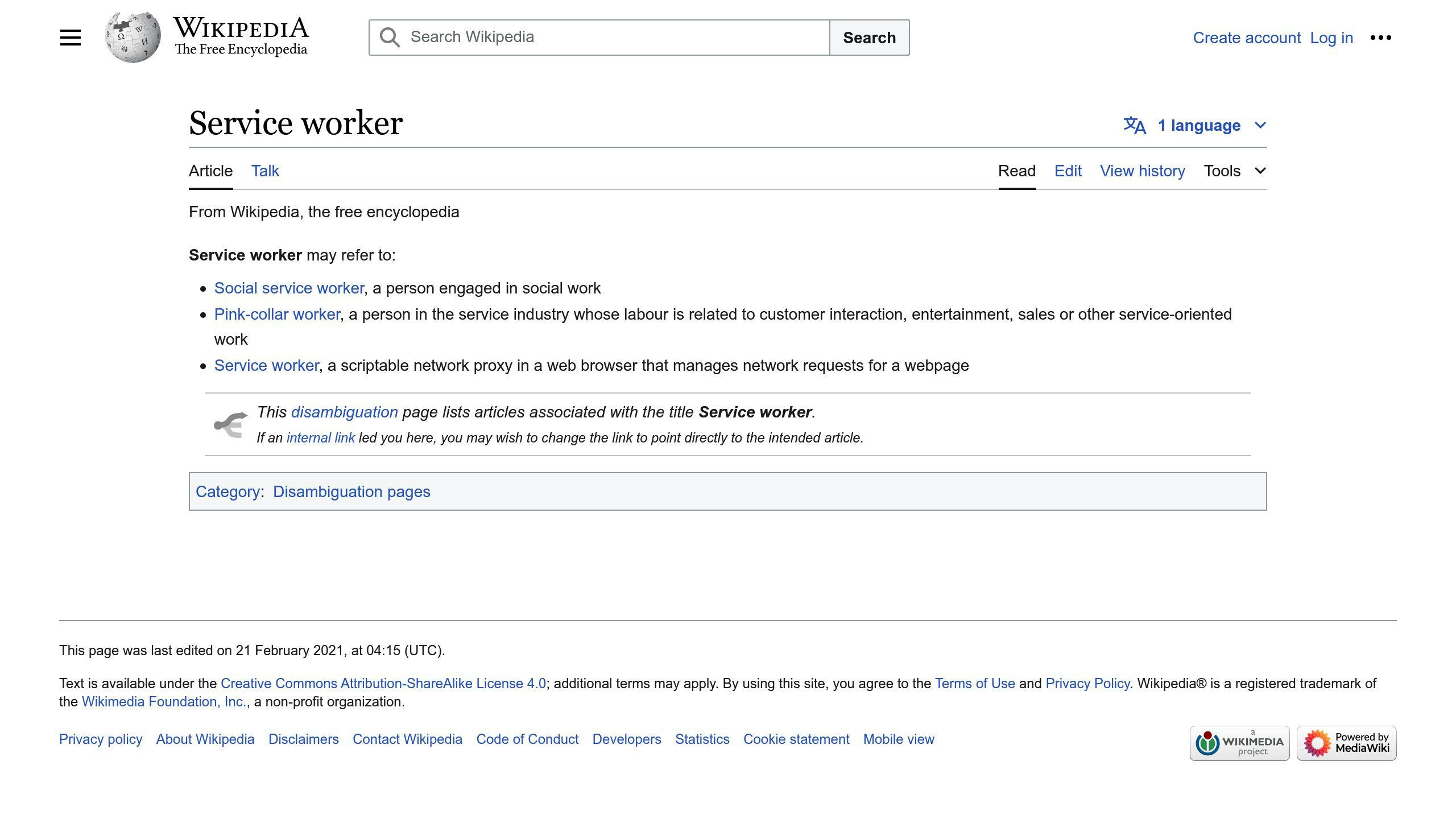Progressive Web Apps (PWAs) use pre-fetching and caching techniques with Service Workers to improve performance and provide a faster, more reliable user experience. Here's what you need to know:
What is Pre-fetching and Caching?
- Pre-fetching downloads resources like images, stylesheets, and scripts in the background before they're needed, ensuring faster page loads.
- Caching stores frequently-used resources on the user's device, reducing network requests and enabling offline use.
- Service Workers are scripts that manage pre-fetching and caching, acting as a middleman between the app and network.
Pre-fetching Resources
TechniqueAdvantagesDisadvantages<link rel="prefetch">Easy to implementLimited caching controlService WorkersMore control and flexibilityMore complex implementation
Caching Strategies
StrategyBest Use CaseProsConsCache-FirstStatic assetsFast, offline supportPotential stale contentNetwork-FirstDynamic contentUp-to-date dataSlower, no offline supportStale-While-RevalidateMixed contentSpeed and freshnessComplexity, potential stale content
Using Workbox for Caching
- Workbox is a set of tools from Google that simplifies caching in PWAs.
- It offers features like precaching, runtime caching, and cache management.
- Workbox supports various caching strategies and helps manage cache updates and deletions.
Performance Impact
- Key metrics: Load Time, Time to First Byte (TTFB), First Contentful Paint (FCP), DOMContentLoaded, Resource Utilization.
- Balance caching with the need for up-to-date content through cache invalidation, expiration, and versioning.
- Optimize cache storage through compression, partitioning, and pruning.
- Monitor and analyze performance metrics regularly.
Best Practices
- Avoid common mistakes like incorrect cache headers, inadequate cache invalidation, and over-caching.
- Handle edge cases like network failures, cache misses, and device limitations.
- Ensure cache consistency through versioning, expiration, and invalidation.
- Test and debug your caching strategy thoroughly.
By implementing pre-fetching and caching with Service Workers, you can create faster, more reliable PWAs that provide a better user experience.
Related video from YouTube
Getting Started
PWA Basics
Progressive Web Apps (PWAs) are web apps that feel like native apps. They use modern web technologies like HTML, CSS, and JavaScript. PWAs offer features such as offline support, push notifications, and home screen installation. They work well on different devices and platforms, providing a fast and reliable user experience.
Service Worker Fundamentals
A Service Worker is a script that runs in the background. It helps manage network requests, cache resources, and provide offline support. The Service Worker lifecycle has three stages:
- Registration: The Service Worker is registered with the browser.
- Installation: Resources are cached.
- Activation: Cache updates and deletions are managed.
Web Caching Concepts
Web caching stores frequently-used resources on the user's device. This reduces network requests and improves page load times. The Cache API allows you to:
- Cache resources
- Manage cache updates
- Delete cache entries
Understanding these basics will help you use resource pre-fetching and caching with Service Workers to create a fast and reliable PWA.
Pre-fetching Resources
Pre-fetching resources speeds up web page loading by downloading and caching resources in the background before they are needed. This improves the user experience, especially for those with slow internet connections.
Pre-fetching with <link rel="prefetch">
Using the <link rel="prefetch"> tag hints to the browser that a resource will be needed soon. The browser downloads the resource in the background and stores it in the cache for later use. This method is easy to implement but offers limited control over caching.
Example:
<head>
<link rel="prefetch" href="script.js">
</head>
Pre-fetching with Service Workers

Service Workers provide more control and flexibility for pre-fetching resources. During the install event, you can precache static assets like images and stylesheets to ensure they are available offline. You can also use Service Worker events to prefetch resources that might be needed later.
Example:
self.addEventListener('install', function(event) {
event.waitUntil(
caches.open(cacheName).then(function(cache) {
return cache.addAll([
'/style.css',
'/image.jpg',
'/script.js'
]);
})
);
});
Comparing Pre-fetching Methods
TechniqueAdvantagesDisadvantages<link rel="prefetch">Easy to implementLimited control over cachingService WorkersMore control and flexibilityMore complex to implement
Caching Strategies
Caching strategies help manage resource requests and responses in Progressive Web Apps (PWAs). Using the right strategy can boost performance and user experience.
Cache-First Strategy
The Cache-First strategy serves resources from the cache first. If the resource is not in the cache, it falls back to the network. This is good for static assets like images, stylesheets, and JavaScript files.
Network-First Strategy
The Network-First strategy fetches resources from the network first. If the network is unavailable, it serves the resource from the cache. This is ideal for content that needs to be up-to-date, like API responses or dynamic content.
Stale-While-Revalidate Strategy
The Stale-While-Revalidate strategy serves resources from the cache first and updates the cache with new data in the background. This balances speed and freshness, making it suitable for mixed content.
Choosing a Caching Strategy
Consider the type of resource, how often it updates, and user needs when choosing a strategy. Here's a comparison table to help you decide:
StrategyBest Use CaseProsConsCache-FirstStatic assetsFast, offline supportPotential stale contentNetwork-FirstDynamic contentUp-to-date dataSlower, no offline supportStale-While-RevalidateMixed contentSpeed and freshnessComplexity, potential stale content
Using Workbox for Caching

What is Workbox?
Workbox is a set of tools from Google that makes caching in PWAs easier. It helps you manage caching so you can focus on building your app. Workbox offers features like precaching, runtime caching, and cache management.
Precaching Assets
Precaching means caching resources during the service worker's install phase. Workbox's workbox.precaching.precacheAndRoute method helps you do this. You need a precache manifest, a list of resources to cache, which you can create using workbox-webpack-plugin or workbox-build.
Example using workbox-webpack-plugin:
// webpack.config.js
const WorkboxWebpackPlugin = require('workbox-webpack-plugin');
module.exports = {
//...
plugins: [
new WorkboxWebpackPlugin.InjectManifest({
swSrc: './src/sw.js',
swDest: 'sw.js',
}),
],
};
Implementing Caching Strategies
Workbox supports various caching strategies like Cache-First, Network-First, and Stale-While-Revalidate. Use workbox.routing.registerRoute to set a caching strategy for a route.
Example of Cache-First strategy:
// sw.js
workbox.routing.registerRoute(
/\.(?:js|css|webp|png|svg)$/,
new workbox.strategies.CacheFirst(),
);
Managing Cache Updates and Deletions
Workbox helps manage cache updates and deletions with features like cache expiration and pruning. Use workbox.cacheExpiration to set cache expiration.
Example:
// sw.js
workbox.cacheExpiration({
maxAgeSeconds: 3600, // 1 hour
});
Debugging and Testing Caching
Workbox offers tools for debugging and testing, like workbox.debug and workbox.testing. Use these to test your caching strategy and debug issues.
Example:
// sw.js
workbox.debug.logLevel = 'debug';
This enables debug logging for your caching strategy, showing what's happening behind the scenes.
sbb-itb-8abf120
Advanced Caching Techniques
Partitioning and Managing Caches
Partitioning caches means separating different types of resources (like images, scripts, and HTML) into their own caches. This helps manage each cache better and keeps things organized.
To create separate caches, use the caches.open() method:
caches.open('image-cache').then(cache => {
// Add image resources to the cache
});
caches.open('script-cache').then(cache => {
// Add JavaScript resources to the cache
});
Cache Expiration and Pruning
Cache expiration sets a time limit for cached resources, so they are removed after a certain period. This keeps the cache from getting too full and ensures users get fresh content.
To set cache expiration, use the cacheExpiration method:
caches.open('image-cache').then(cache => {
cacheExpiration({
maxAgeSeconds: 3600, // 1 hour
});
});
Cache pruning removes unused or outdated resources to free up space. Use cache.keys() to list cached items and cache.delete() to remove them.
Caching Cross-Origin Resources
Caching resources from other origins can be tricky due to browser security rules. Here are two ways to handle it:
- Use the
Access-Control-Allow-Originheader:
Access-Control-Allow-Origin: https://example.com
- Use a proxy server to cache and serve the resource, bypassing cross-origin restrictions.
Network-Based Cache Responses
You can serve different cached resources based on the user's network speed. Use the Network Information API to detect network conditions:
navigator.connection.addEventListener('change', () => {
if (navigator.connection.downlink > 10) {
// Serve high-quality cached resources for fast connections
} else {
// Serve low-quality cached resources for slow connections
}
});
Performance Impact
Performance Metrics
To measure the impact of pre-fetching and caching, focus on these key metrics:
- Load Time: Time for the page to fully load.
- Time to First Byte (TTFB): Time for the browser to get the first byte from the server.
- First Contentful Paint (FCP): Time for the browser to show the first piece of content.
- DOMContentLoaded: Time for the browser to finish parsing the initial HTML.
- Resource Utilization: CPU, memory, and network resources used by the page.
Monitoring these metrics helps understand how pre-fetching and caching affect performance.
Balancing Caching and Freshness
Balancing caching with the need for up-to-date content is crucial. Here are some strategies:
- Cache Invalidation: Periodically update cached resources.
- Cache Expiration: Set a time limit for cached resources.
- Content Versioning: Use version numbers or timestamps to ensure users get the latest content.
Optimizing Cache Storage
Optimizing cache storage ensures caching doesn't hurt performance. Techniques include:
- Cache Compression: Compress cached resources to reduce size.
- Cache Partitioning: Separate cached resources into smaller chunks.
- Cache Pruning: Remove unused or outdated cached resources.
Monitoring and Analyzing Performance
Regularly monitor and analyze performance metrics to ensure caching strategies are effective. Useful tools include:
- Lighthouse: Provides detailed performance metrics and recommendations.
- PageSpeed Insights: Analyzes page performance and offers improvement tips.
- WebPageTest: Offers detailed performance metrics and waterfall charts to identify bottlenecks.
Best Practices and Common Pitfalls
Common Mistakes and Pitfalls
Avoid these common mistakes when implementing caching strategies:
- Incorrect cache headers: Misconfigured headers can lead to stale content, cache misses, or security issues.
- Inadequate cache invalidation: Not updating cached resources can result in users seeing outdated content.
- Over-caching: Caching too many resources can increase storage needs and slow performance.
Handling Edge Cases and Fallbacks
Consider these scenarios when planning your caching strategy:
- Network failures: Plan how your app will handle network issues.
- Cache misses: Decide what happens when a resource isn't cached or has expired.
- Device limitations: Ensure your app works on devices with limited storage or processing power.
Ensuring Cache Consistency
Keep your cache consistent to provide the latest content:
- Cache versioning: Use version numbers or timestamps to ensure users get the latest content.
- Cache expiration: Set time limits for cached resources to keep them updated.
- Cache invalidation: Regularly update cached resources.
Testing and Debugging
Thorough testing and debugging are crucial:
- Use developer tools: Inspect cache headers, resource timings, and network requests with browser tools.
- Test edge cases: Check your app under various network conditions and device limitations.
- Monitor performance metrics: Track load time, TTFB, and resource use to ensure effective caching.
Conclusion
Benefits Summary
Using resource pre-fetching and caching with service workers can make PWAs faster, more reliable, and better for users. This leads to quicker page loads, fewer network requests, and offline use, which can increase user engagement and satisfaction.
Key Takeaways
When building a PWA, remember to:
- Understand service workers, caching, and pre-fetching basics
- Choose the right caching strategy for your app
- Implement caching and pre-fetching correctly to avoid common mistakes
- Test and debug your caching strategy thoroughly
- Continuously monitor and optimize your app's performance
Further Learning
For more information on PWAs and caching, check out these resources:
- Service Worker API documentation
- Google's Web Fundamentals guide to caching and pre-fetching
- Workbox library for caching and routing
- Online courses and tutorials on PWA development and caching strategies
FAQs
How to cache with a service worker?
To cache resources with a service worker, use a cache-first strategy. This means:
- Check if the resource is in the cache.
- If it is, serve it from the cache.
- If not, fetch it from the network, store the response in the cache, and return the network response.
How to cache data using a service worker?
To cache data using a service worker:
- Check the request's destination property to see if it's an image request.
- If the image is in the cache, serve it from there.
- If not, fetch the image from the network, store the response in the cache, and return the network response.
This ensures your app can load resources efficiently, even with a slow or unavailable network.












